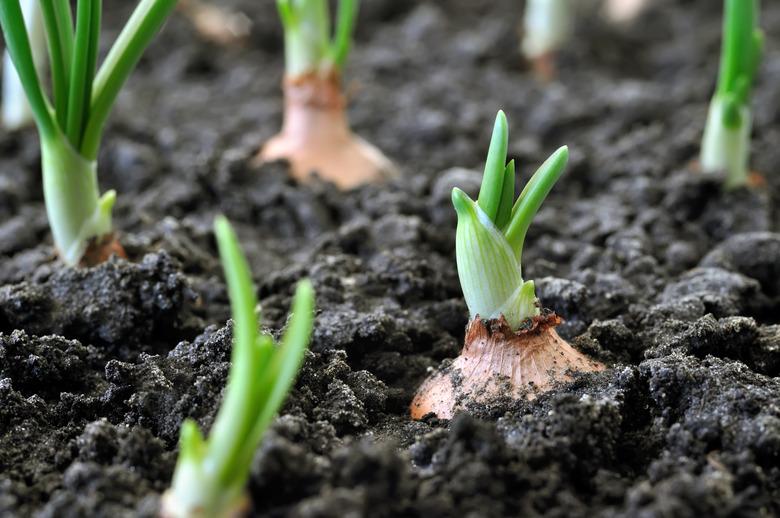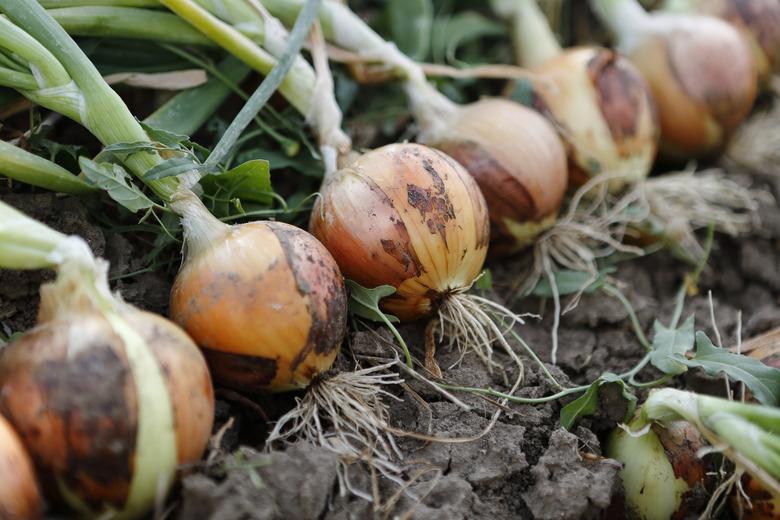How To Grow Onions
We may receive a commission on purchases made from links.
Whether you enjoy the sweet, mild taste of spring onions or you prefer a meatier crop, you can grow onion plants (Allium cepa) in your backyard garden. These tasty plants are easy to grow, but they like lots of nitrogen and will need fertilizing if your soil is lacking. You'll also need to watch their water intake closely. Onions have an excellent poker face — the only sign they'll give you that they're getting too little water will be a cracked onion bulb, and you won't see it until harvest time when it's too late.
If you like your onions on the sweeter side, there are plenty of onion cultivars from which to choose. You can also make your onions taste a bit sweeter by watering them more often. Onions grow in full sun but stay compact as they grow, making them an excellent vegetable for gardeners with limited space. They require full sun and well-draining soil for best results.
Best Uses for Onions
Best Uses for Onions
Onions don't add much visual appeal to the garden, but this vegetable has an incredible number of uses in the kitchen. Though they're short on nutrition and don't add many vitamins to your diet, they will absolutely add flavor. You can eat onions raw in a salad or on a burger. You can even nibble on spring onions by themselves for a tasty snack.
Onions can also be deep fried to make onion rings, sauteed for a steak or grilled for shish-kebobs. You'll often find onions added to soups for a bit of flavor, and onion lovers make French onion soup that features onions rather than just using them for a flavor boost. They're super versatile and add a pleasant punch to almost any savory dish.
It can take onions three to four months to go from seed to harvest, so you may want to start seeds indoors.
- Sow them in a seed-starting tray eight to 10 weeks before you expect the last frost.
- Place three or four seeds in each cell of the starter tray, water them and place the tray in a warm but well-ventilated area.
- When the seeds germinate and the young onion shoots start to poke through the soil, place the seed tray where it can get adequate light. Alternating periods of 12 hours of daylight and 12 hours of darkness are best, but do what you can with the space you have. You can supplement your natural light with artificial growing lights if necessary.
Starting Onions From a Seedling
Starting Onions From a Seedling
If you've been growing your own seedlings indoors, start setting them outside in spring for a few hours at a time to acclimate them to the cooler outdoor temperatures before transplanting them. Leave them out a little bit longer each day.
A few weeks after your final frost, plant the seedlings in your garden, spacing them 4 to 6 inches apart. Keep rows of onions about 12 inches apart so you can easily walk and work between them. Onions keep fairly shallow roots, so there is no need to dig deep planting holes. Holes and trenches just deep enough to cover the plant's roots are good enough, and 1 inch of depth will do the trick.
If desired, you can expedite the growing process a bit by planting onion sets. "Onion sets" is just a fancy term for small onion bulbs that were grown and harvested the previous year. You can plant sets instead of seedlings, thus eliminating the need to start seeds indoors. You'll find sets and seeds at your local garden center, but seedlings may be easier to find online. Seedlings are more prone to disease than sets or seeds, which is why not every nursery sells them.
In What Zone Do Onions Grow Best?
In What Zone Do Onions Grow Best?
Like most vegetable crops, onion plants last only one growing season. As such, you can grow them as an annual anywhere in USDA hardiness zones 3 through 9 without problems. After you harvest your onions, they're finished, and you'll have to replant them again next year. Some types of onions are biennials in zones 5 through 10, which means they'll overwinter in the ground for a spring harvest.
Onions are, however, sorted into growing regions. Growers in the northern United States fare better when growing long-day onion varieties. Long-day varieties are those that begin forming bulbs when they receive 14 to 16 hours of sunlight per day. These onions are best suited for gardens at a latitude of 37 to 47 degrees.
Short-day onions, in contrast, grow at altitudes of 25 to 35 degrees and will form bulbs with only 10 to 12 hours of sunlight per day. Grow short-day onions if you live in the southern United States. For gardeners in the middle, there are intermediate-day onions that form bulbs when exposed to 12 to 14 hours of daylight or latitudes between 32 and 42 degrees.
When Should You Plant Onions?
When Should You Plant Onions?
Onions are quite easy to grow and require very little maintenance. Plant onions in full sun two to four weeks after your area's last frost and when the nighttime temperatures stop dipping below 28 degrees Fahrenheit. When the onions reach a few inches in height, mulch around them to help them retain moisture and keep weeds down.
Gardeners in colder regions may have to wait until the ground is workable to plant their onions. This usually occurs in late March or April. Those in warmer regions can often plant their onions a bit sooner in late winter rather than waiting until early spring.
Soil, Sunlight and Water Recommendations for Onions
Soil, Sunlight and Water Recommendations for Onions
Onions require several hours a day of full sun and about an inch of water a week. The more water they receive, the sweeter they will taste, but don't let them get soggy. Although they like their soil evenly moist, they don't like puddles or wet feet.
Onions grow best in a loamy, well-draining soil with a fairly neutral pH level of 6 to 6.8. If your soil is acidic, amend it with some sulfur. If you have clumpy, wet soil like clay, incorporate organic matter into the planting bed before planting to keep your onions happy.
Fertilize your onions with a nitrogen-rich fertilizer every two weeks during the growing season, stopping when you see the tops of the onion bulbs start to breach the soil. If you prefer, you can till some compost into your soil before planting and then skip the fertilization during the growing season. Either fertilization method is acceptable.
It's best to keep onions consistently moist if possible. Consider installing a drip irrigation system in order to achieve this. You can also dig a small trench in the dirt alongside your onions and fill it with water periodically. This allows the water to seep into your onion plantings, going straight to the roots where it's needed.
Although your onions will taste sweeter at harvest time if they receive a good amount of water, don't take this as permission to send your onions swimming. Onion roots are small and notoriously bad at soaking up water, so constant moisture is a must. Puddles in poorly draining soil promote rot and fungi, though, so make sure the soil around your onions is moist but never soggy or wet.
How to Harvest Onions
How to Harvest Onions
Harvest your onions when the tops turn brown.
- Pull them out of the ground and allow them to lay in the sun for a day or two.
- Lay them on a screen where they can finish drying before you store them.
- Onions are ready to go to storage when no white liquid oozes out of them when they're cut.
- Store onions in a mesh bag or old stockings in temperatures between 40 and 50 degrees.
Common Pests and Other Problems for Onions
Common Pests and Other Problems for Onions
No matter where you grow, you may find your onion crop attracting some unwanted insect attention. Tiny tan insects called thrips like to live in and munch on onion greens. To check for them, tap your onions over some dark paper. If they're present, the tan thrips will show up easily against the dark background.
Luckily, getting rid of thrips is easy. To do so, purchase insecticidal soap and spray the plants liberally. Wait two days and then spray again. This is usually all it takes to ward off thrips.
Onion maggots can also prove to be problematic. These pests lay their eggs at the base of onion plants where they will have plenty of food upon hatching, You can keep the maggots out by covering your onions with a mesh netting and securing it firmly around the edges. Onion maggots typically don't cause problems during dry seasons, so you're more likely to find them if you have lots of rainy weather.
Common Diseases for Onions
Common Diseases for Onions
Onions can experience rots caused by different pathogens, including botrytis, purple blotch and downy mildew. These diseases plague home gardens infrequently, however, and are more troublesome in commercial crops. To prevent them at home, grow your onions in well-draining soil and water them using drip irrigation or furrow irrigation rather than using a garden hose, watering can or sprinkler.
To further protect your harvest, rotate your crops rather than planting your onions in the same garden spot over and over again. Make sure you store your harvested onions in a cool, dry place. Onions often show signs of botrytis in storage rather than in the garden.
References
- Purdue University Cooperative Extension Service: Diagnosis and Control of Onion Diseases
- The University of Vermont Extension: Onion Diseases – An Overview
- Gardener's Path: How to Grow and Care for Bulb Onions
- Bonnie Plants: Growing Onions
- The Old Farmer's Almanac: Growing Onions
- Sunset: Acid or Alkaline Soil: Modifying pH
- Johnny's Selected Seeds: Onion Bulb Formation, Daylength & Latitude


